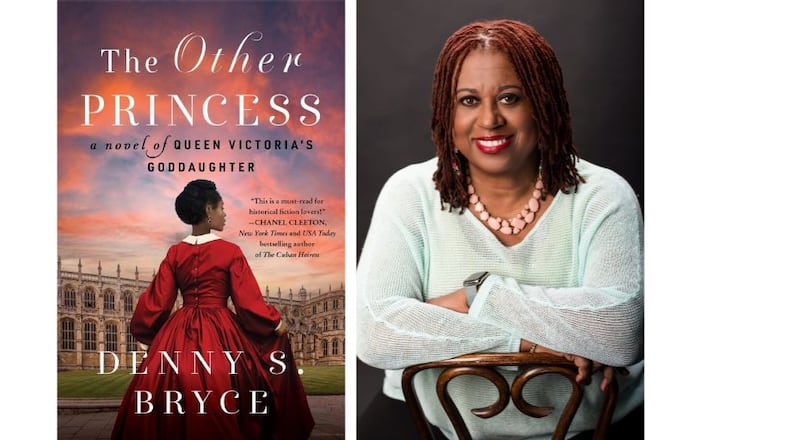In 1850, British Royal Navy commander Capt. Frederick Forbes returned from a diplomatic mission in West Africa with a unique gift for Queen Victoria — a child. Sarah Forbes Bonnetta was an enslaved 7-year-old Yoruba princess who was a gift from “the King of the Blacks to the Queen of the Whites,” as stated in Forbes’ diary. In “The Other Princess: A Novel of Queen Victoria’s Goddaughter,” Atlanta author Denny S. Bryce has transformed Bonetta’s imprint on history into a fictional epic that illuminates her distinctive experience.
Bryce’s narrative opens in 1843 as the Okeadon queen is birthing her seventh child. Queen Kayin names her baby Aina to denote she was born with the cord around her throat, and she scars the child’s face to signify she’s royalty. Kayin hopes the markings will spare Aina from being sold into slavery if she is captured by the neighboring Dahomey.
“Fear was the cord around my neck those first days,” Aina states, as the cord makes a symbolic reappearance when her family is slaughtered by the Dahomey and she’s thrown into a tent with hundreds of others to be sold or sacrificed.
Yet Kayin’s foresight pays off. Five-year-old Aina survives and becomes a precocious child who spends a few years in an encampment searching for the brother she believes is alive. He escaped wearing their father’s bluestone necklace that provides her only link to her ancestry. The necklace becomes another cord around Aina’s neck that appears throughout the narrative and provides a compelling tether to her history.
Along with the massacre of her family, the “watering of the ancestral graves” ceremony, in which the Dahomey’s King Gezo indiscriminately beheads of some of his captives, is a gruesome scene relayed through the eyes of a small child. Bryce’s depiction is not graphic, though. Instead she focuses on the mental skills Aina develops as a result of witnessing such brutality and which carry her through many hardships in life. Unsurprisingly, witnessing these horrors shapes her personality and impedes her ability to bond with others.
Capt. Forbes interrupts the horrific ceremony hoping to negotiate the end of the Dahomey’s participation in the transatlantic slave trade. In a tense moment, he asks if Aina, the next to be sacrificed, could be gifted to his sovereign to bond their two countries. Gezo agrees; Ania is baptized with the biblical first name Sarah and given the middle name Forbes. Her last name, Bonetta, comes from Forbes’ ship, the HMS Bonetta.
Forbes is a virtuous figure who invests significantly in fashioning Sarah into the queen’s goddaughter. And on the voyage to England, Sarah forms a bond with Forbes’ steward William. He teaches her English, introduces her to literature and sparks her love of Jane Austin. The princess easily charms the sailors, except for one who feels entitled to appropriate the bluestone necklace she recovered before leaving Africa.
Abandonment is a recurring theme in Sarah’s life. Tragedy again strikes when she loses William. But by then, she’s already learned that “the hurt in my body was too deep for something as shallow as tears.” Being severed from nearly every confidante throughout her life, from childhood comrades at the encampment to those she holds dear in adolescence, leaves her emotionally estranged.
In England, Sarah shifts her focus to things instead of people because losing objects hurts less. And sparkly events provide a wonderful distraction from her pain. Upon their meeting, Victoria receives her gift stating, “a person cannot be given to another.” Still, she’s impressed with Sarah’s excellent English, skilled piano playing and ladylike demeanor, and gladly assumes Sarah as her ward. While Sarah resides with the Forbes family, she becomes a frequent guest at Windsor Castle and dear friend to Victoria’s daughter, Princess Alice.
Bryce has crafted a commanding Victoria to strike against Sarah’s strong personality. The queen is a woman ruled by 19th century convention and has very specific ideas for Sarah’s future. Sarah, born a princess and elevated by Victoria’s favor, grows accustomed to luxury and being treated like royalty. A handful of figures resent her privilege and try to thwart her along the way, especially as Sarah voices opposition to the queen’s decisions. But just as frequently, she’s received with fascination and occasionally respect.
Contingent upon Victoria’s mercy, Sarah’s position is secure as long as she does as she’s told and stays healthy. But she is plagued with frequent sickness and a lingering cough, so Victoria deports Sarah indefinitely to the Female Institution in Freetown, Sierra Leone, to complete her education and recover her health. Sarah is terrified to return to the continent where Gezo slaughtered her family. The nearby Dahomey are still at war, and she’s enraged by the queen’s callousness.
She also chafes against the profession Victoria has chosen for Sarah — missionary to help England establish the African colonies. Sarah wants to write novels like Jane Austin. But nothing disrupts Sarah’s life more than the man the queen decides she must marry. Toward the end of an accomplished life, Sarah reflects on her benefactor saying, “The queen is forever thoughtful — and forever cruel,”
Bryce has crafted a comprehensive portrait of Sarah Forbes Bonnetta using a single timeline, single narrator structure that imparts a biographical quality to the storytelling and takes time to unfold. As it does, an intimate rendering of a fascinating historical figure comes to life. Bonetta’s existence was fraught with extremes — loss and redemption, desolation and opulence, terror and love. Bryce’s sweeping depiction in “The Other Princess” delivers them all.
FICTION
“The Other Princess”
by Denny S. Bryce
William Morrow, 448 pages, $19.99
About the Author
Keep Reading
The Latest
Featured


